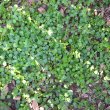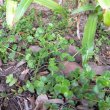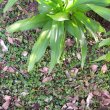| Botanical Name |
|
| Family |
Crassulaceae - The crassula family. |
| Pronunciation |
KRASS-oo-la spath-yoo-LAY-tuh |
| Common Name(s) |
|
| Plant Group |
- Succulent A plant having fleshy stems or leaves often adapted to dry conditions.
|
| Plant Size |
- Small
| Tree | 4m to 8m |
| Shrub | 50cm to 75cm |
| Perennial/ground cover | 10cm to 20cm |
| Bulb | 20cm to 30cm |
| Succulent | 10cm to 20cm |
|
| Position |
- Canopy Shade Canopy shade is found below closely grown trees where some light filters through. Ideal for the protection of herbaceous plants.
- Light or Dappled Shade Found below trees with sparse, open foliage. Ideal for the protection of herbaceous plants.
- Partial Shade The area is in shade for part of the day and in full sun for part of the day.
- Sun The area is in full sun for all or most of the day, all year round.
|
| General Information |
- Drought Tolerance: High The plant is well adapted to arid conditions; it can survive long periods of drought and high temperatures without extra water.
- Evergreen Plants that have leaves all year round.
- Frost: Half-hardy The plant is able to survive low temperatures and some frost but requires protection against severe frost.
- Roots Non-invasive Safe to plant near pools, paving, walls or buildings.
- Water Wise Plant species originating from low rainfall regions that require less water to survive and thrive than other plant species.
|
| Specific Information |
Crassula spathulata is a low growing, creeping or mound forming succulent. The leaves are small, rubbery and spade-shaped,10 to 20 mm across, with finely scalloped edges.
I have found this little succulent particularly useful as a ground cover between summer flowering bulbs, where it soon forms a dense mat, conserves moisture and is excellent for discouraging weeds. It is also very attractive in hanging baskets and as a ground cover in containers, where it hangs attractively over the edges.
|
| Ad Break |
|
| Flowers |
| Description |
small, star-shaped with five pointed petals
|
| Season |
- Summer to Autumn Plants will seldom bloom for the entire season as given in the list, but should flower during a period within these parameters.
|
| Colour |
|
| Growth Rate |
- Very Fast Specifying growth rate can be very misleading as there is considerable variation of growth rate depending on type and species of plant, available water, supplementary feeding, mulching and general care, as well as the plants suitability and adaptability to the garden environment.
|
| Plant Uses |
- Border A strip of ground, at the edge of a driveway or path in which ornamental plants or shrubs are planted.
- Container Trees, shrubs and ornamental species that can adapt to growing in a restricted environment.
- Edging A low growing plant that provides softness or definition to the edges of a bed or walkway.
- Filler Either a fast growing tree or shrub used temporarily to fill in an area while the permanent plants grow to a desired size, or a plant used to fill gaps in borders or beds.
- Ground Cover Low-lying plants that spread fast, require minimal maintenance, and cover large expanses or bare areas between bulbs or shrubs. They provide protection from erosion and drought and improve the visual appearance of the garden.
- Interplanting Arranging and planting plants in the garden that have different blooming times and habits of growth, extending the amount of time in which the area is in flower.
- Retaining Walls Shallow rooted plants for cascading over dry stone walls or planting in hollow spots in retaining blocks.
- Rock Garden An area constructed of larger rocks, arranged naturally, to emphasise the use of stones as a main element. Generally plants used do not need a lot of care.
- Stabilize Banks Plant is used to prevent soil erosion because their roots will form a mat that stabilizes the soil and keeps it from washing away in heavy rains.
- Suitable for coastal gardens Plants adapted to dry, sandy soil, forceful wind, limited rainfall and intense sunlight.
- Suitable for smaller gardens Such plants do not have invasive root systems, remain small or controllable and can often be grown in containers.
- Wild Garden An indigenous garden planted for the benefit of wildlife and birds. Provides food, water, a variety of mini-biomes and no poisonous chemicals are used.
|
| Distribution and Habitat |
from Knysna in the Western Cape, through the Eastern Cape and north into KwaZulu-Natal, on rocky outcrops along forest margins
|
| Planting Suggestions |
Crassula spathulata is very easy to grow, rooting quickly from cuttings. It grows best in lightly shaded positions. If grown in full sun the leaves may turn slightly red and I have found it does not thrive if grown in a position where it is exposed to hot sun for long periods. It grows in most soils as long as drainage is sufficient.
|
| Medicinal Uses |
|
| Ad Break |
|







Comments
Crassula spathulata
Does Crassula spathulata grow under full shade conditions?
Crassula spathulata in full shade
Hi Anele
In my garden I have noticed that this is definitely a shade-loving plant and grows very well in full shade. It may not make a thick mat if the shade is very dark but I can't be sure of this.
Kind regards
Lorraine
Discuss this plant
Share knowledge, ask a question or give an experience.